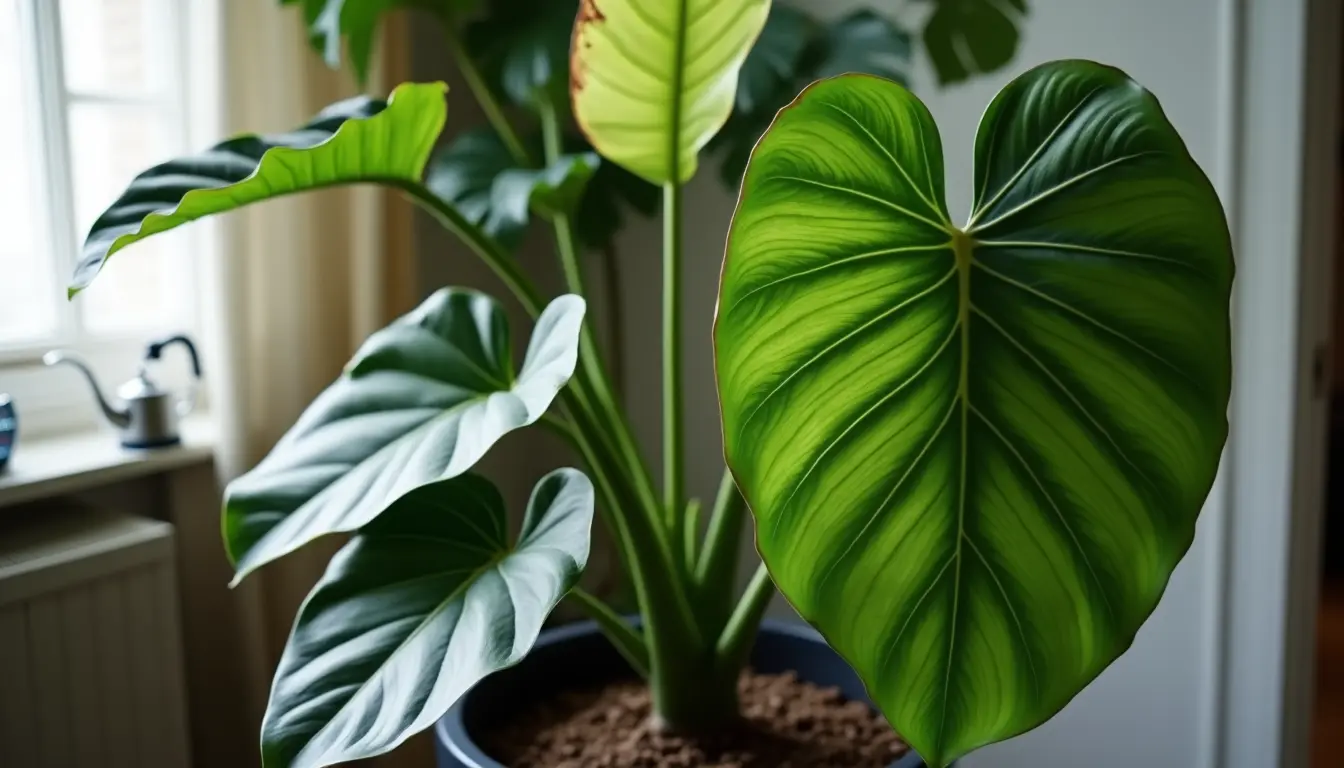Your elephant ear plant doesn’t look like the showstopper it once was? You’re not alone. These tropical beauties can be surprisingly finicky, despite their dramatic appearance. My experience caring for over 80 plants has taught me that elephant ear plants need specific attention to truly thrive.
Many indoor plant enthusiasts face similar challenges with elephant ear plant care. The signs something’s wrong appear as yellowing leaves, drooping stems, and brown edges. The silver lining? A few common mistakes cause most elephant ear plant indoor problems. These tropical plants need humidity levels around 40-50 percent and proper watering techniques to revolutionize their health.
Let me walk you through the reasons your elephant ear plant might be struggling. This piece offers expert solutions to revive it. We’ll explore everything from adjusting watering schedules to finding the perfect light conditions. Your success with elephant ear plant care indoors or outdoors in 2025 depends on these essential factors.
Common Signs Your Elephant Ear Plant Is Struggling
Your elephant ear plant tells you when something’s wrong. These tropical beauties show signs of distress through visible changes that point to the problem.
Yellowing leaves and what they mean
Yellow foliage often signals the first warning in elephant ear plants. Older, lower leaves might turn yellow and fall off naturally. But when multiple leaves yellow at once, something isn’t right.
Leaves that turn pale or yellow while keeping green veins usually point to missing nutrients, especially when you have low nitrogen or micronutrients. This imbalance stops chlorophyll from developing properly and creates distinct color patterns.
Water problems often cause yellowing too. Too much water drowns the roots in soggy soil, while too little stops nutrient transport. Both problems show up the same way – yellowing spreads across the whole leaf.
Light issues can also cause problems. Lower leaves turn yellow and drop as plants try to save energy in low light. Too much direct sun can bleach the foliage and create uneven discoloration.
Drooping stems and possible causes
A drooping elephant ear plant with its magnificent leaves sagging to the ground looks sad. Stems usually droop from water stress – but you’ll need to check the soil to know if it’s too wet or too dry.
Stems or roots that feel soft and mushy mean too much moisture. Your plant needs water if leaves curl while stems droop. Roots packed tight in a small pot can make stems droop by limiting water and nutrients.
Poor lighting makes stems weak over time. They can’t hold up those impressive leaves anymore. Changing temperatures stress the plant and make the foliage droop too.
Pests like spider mites or aphids can weaken the entire plant. Look under the leaves for tiny bugs or webbing if drooping continues even with good care.
Brown edges and dry spots explained
Brown, crispy leaf edges usually mean environmental stress, not disease. The most common cause is leaf scorch from too much direct sunlight burning delicate leaf edges.
Water stress shows up as brown leaf edges too. As elephant ears get bigger, their large leaves just need more water. Regular watering might not be enough for mature plants.
Dry indoor air makes leaf edges crisp and brown, especially near heaters or air conditioners. Quick temperature drops can damage leaves and turn them brown.
Fungal problems look different – they create separate brown spots with yellow rings around them. This happens when water splashes on leaves during watering and creates perfect conditions for fungi to grow.
Note that finding out what’s wrong with your elephant ear plant means looking at all these symptoms together to get the full picture of your tropical beauty’s health.
Top Reasons Why Your Elephant Ear Plant Isn’t Thriving
Your elephant ear plant’s health problems need a good diagnosis and understanding of what’s causing them. Let me walk you through four common problems that could slow down your plant’s growth.
Incorrect watering habits
Getting the water balance right for elephant ear plants isn’t easy. These tropical beauties like their soil moist but run into trouble with too much water. Soggy conditions deprive roots of oxygen and cause root rot with yellow leaves. The plant droops and wilts when the soil dries out completely.
The plant grows best when you water it deeply once the top inch of soil feels dry. Plants in containers usually need daily water during summer. Your 2-3 year old outdoor plants should get 2-3 inches of water each week in growing season.
Poor lighting conditions
Elephant ear plants are picky about their light. They grow weak with stretched stems and tiny leaves in low light. Direct sunlight isn’t good either – it burns those beautiful leaves and leaves scorched edges.
These plants do best in bright, indirect light. Put them near east or north-facing windows inside your home to get filtered sun. Outside, they love morning sun but need shade in the afternoon. Your plant might not be getting enough light if you notice stretched stems or smaller new leaves.
Wrong soil type or poor drainage
These plants just need rich soil that drains well and has lots of organic matter. A mix of peat moss (or coir), perlite, and quality potting soil works great to keep moisture while letting excess water drain.
Bad drainage leads to root rot, and packed soil doesn’t let roots breathe. Both problems show up as yellow leaves and slow growth. Make sure your pots have enough drainage holes so water doesn’t collect at the bottom.
Lack of humidity indoors
The sort of thing I love about elephant ear care is how much humidity matters. These tropical plants need 60-70% humidity. Indoor air is nowhere near moist enough, especially in winter.
Low humidity makes leaf edges turn brown and crispy even with proper watering. You can fix this by using humidity trays, keeping plants close together, or running a room humidifier to create a better environment for your tropical beauty.
How to Fix Common Elephant Ear Plant Problems
Your elephant ear plant can bounce back to its dramatic, lush self with a few simple changes to its care routine. Let’s look at the solutions now that we know what’s causing the problems.
Adjusting your watering schedule
The quickest way to get watering right is to check the soil regularly. Stick your finger about an inch deep into the soil – if it feels dry, your plant needs water. Plants in containers might need daily watering during summer, while 10-year old outdoor plants can go longer between waterings.
Give the soil a good soak until water runs from the drainage holes, then let all the excess drain away. Wait for the top inch to dry before watering again. Note that winter dormant plants need nowhere near as much water – only water after the top 2 inches of soil feel dry.
Finding the right spot for light
These plants love bright, indirect light. Put your plant near a south or east-facing window to catch morning sun while staying safe from harsh afternoon light. Move it away from direct sun or add a sheer curtain if leaf edges get scorched.
Plants growing outdoors do best with morning sun and afternoon shade. Keep an eye on leaf color – pale leaves mean not enough light, while burnt spots show too much sun exposure.
Choosing the best soil mix
Mix these ingredients for perfect growing conditions:
- Peat moss or coco coir (base material)
- Perlite or pumice (for drainage and aeration)
- Compost or worm castings (for nutrients)
- Orchid bark (for structure)
This mix holds moisture but lets extra water drain away. The soil should feel spongy without getting soggy. A slightly acidic to neutral pH (5.5-7.0) helps your plant absorb nutrients best.
Boosting humidity for indoor plants
Indoor elephant ears thrive when humidity stays above 50%. Here are some economical solutions:
- Set the pot on a pebble tray with water (keep pot bottom above water level)
- Create a humid microclimate by grouping plants together
- Add a humidifier near your plant
- Mist leaves in the morning so they dry during the day
Good air flow matters even with higher humidity to stop fungal problems.
Preventing Future Issues with Elephant Ear Plant Care
Your elephant ear plants need a proactive approach that goes beyond solving immediate problems. These tropical beauties require specific attention all year to prevent issues before they start.
Setting a seasonal care routine
A well-laid-out care schedule helps elephant ear plants thrive year-round. The growing season demands balanced liquid fertilizer every two weeks to support vigorous growth. Winter months naturally slow growth, so you should stop feeding completely.
Your elephant ear plants will enter dormancy periods where everything above soil dies back. This natural process shouldn’t worry you – just water much of either to keep soil from drying completely. Wait until spring brings new growth before fertilizing again.
Temperature control is significant – your plants need daytime temperatures between 70-80°F (21-26.6°C) and nighttime temperatures around 55°F (13°C) to stay healthy.
Monitoring for pests and diseases
Spider mites threaten elephant ear plants most often, especially when you have dry indoor environments. Check leaf undersides for tiny red specks or fine webbing each time you water. Early detection through regular leaf checks prevents severe infestations.
Water at soil level instead of overhead to avoid fungal problems. Unlike other houseplants, elephant ears need proper ventilation to stay fungus-free, so give them enough space.
Regular inspections combined with higher humidity and clean plants naturally keep pests away without chemicals.
When and how to repot your plant
Your plant needs repotting every 2-3 years or when roots show through drainage holes or soil surface. Spring works best since it matches the plant’s natural growth cycle.
Choose a pot just 1-2 inches wider than the current one – bigger jumps can shock the plant. The repotting process should keep the root system intact:
- Tip the pot sideways to remove the plant gently
- Look at roots and trim only dead parts (black instead of white)
- Use fresh, well-draining soil and plant at the same depth
The plant’s growth rate means you’ll need patience after repotting – skip fertilizing for a month while it settles in.
Conclusion
Growing healthy elephant ear plants needs careful attention to detail. In this piece, we explored why these tropical beauties don’t thrive indoors and outdoors. Yellow leaves, drooping stems, and crispy edges point to specific care problems that become easy to fix once you spot them.
The right water balance is the key to your elephant ear’s success. These plants need soil that stays damp but never gets soggy to grow vibrantly. On top of that, bright indirect light shields those magnificent leaves and supports healthy growth. Soil that drains well and contains organic matter matches their natural habitat. Good humidity levels stop those annoying brown edges from forming.
Most elephant ear plant problems come from not understanding their tropical nature. These plants do best when their native environment gets recreated – warm temperatures, steady moisture, filtered light, and humid air. My work with dozens of plants shows that small changes can dramatically improve their health.
Your elephant ear plant can bounce back from struggling to thriving with steady care. The seasonal changes we covered and regular checks will stop future problems early. Note that these plants forgive mistakes easily. Many plants that seem beyond saving show exceptional resilience once they get the simple care they need.

